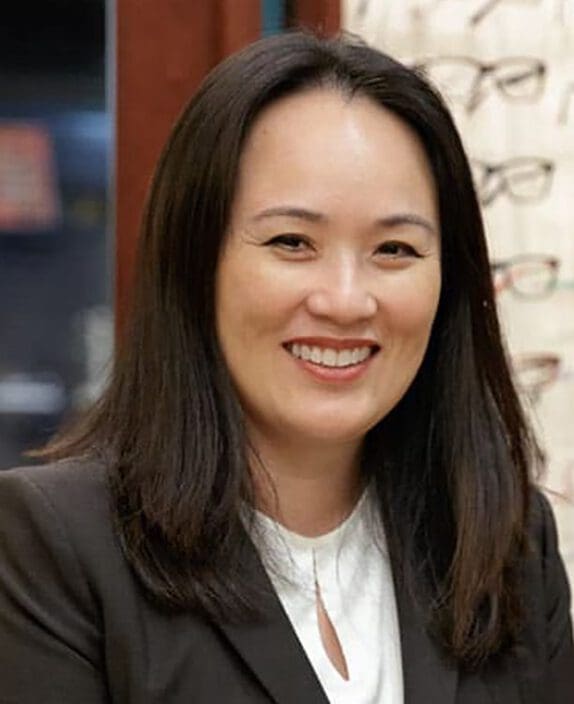
Eye Associates of South Texas: Gonzales
Eye Associates of South Texas - Gonzales
Cataract Surgery and LASIK Surgery in Gonzales, Texas
Eye Associates of South Texas in Gonzales is part of the NVISION® Network. We perform laser-assisted cataract surgery and advanced LASIK eye surgery, as well as other surgical and medical eye procedures and treatments.
Cataracts & Cataract Surgery: What You Need to Know
Cataracts occur when the lens in your eye loses clarity, leading to vision loss and if left untreated, inevitable blindness. Age-related cataracts occur as people get older, although some people are born with cataracts or get them as a result of trauma to the eye or other risk factors.
Cataracts develop over time, and during the first stages you can usually correct your vision with glasses, so surgery is not required at this stage. However, once cataracts begin to affect your ability to do everyday tasks, you need to have surgery to restore your vision.
Cataract Surgery, Insurance, and Premium Options in Gonzales, TX
During surgery, the natural lens of the eye with the cataract is removed, and an artificial intraocular lens (IOL) is implanted. There is a wide range of IOLs available, and the best IOL for you depends on your vision needs, lifestyle, preferences and budget.
Insurance will only cover traditional cataract surgery with a basic lens. While this basic plan ensures that you get clear vision, you will need glasses after surgery, since basic lenses only provide clarity at one single point of focus.
If you would like to enjoy a wider range of vision after the surgery, reducing the need for glasses, a premium IOL is the way to go. Because these advanced lenses require a lot of precision upon implantation to guarantee the best results, it is also recommended that you opt for the advanced laser-assisted cataract surgery technique, which provides greater accuracy than the traditional method.
Laser-Assisted Cataract Surgery in Gonzales, TX
Laser-assisted cataract surgery (LACS) uses a laser to make cuts and soften the cataract. This method allows for precise cuts and may improve vision better than traditional surgery. It’s especially good for people who will be getting advanced lenses like multifocal, toric or light-adjustable lenses, as laser-guided precision cuts increase the odds of a perfect fit.
Intraocular Lens Options
There are several IOL options available to cataract patients, each providing unique advantages. Because some minor side effects can occur, patients should explore their options before getting surgery to make sure they are getting the best choice for their particular case.
Monofocal Lenses
Monofocal lenses correct vision at one distance, usually for seeing far away. People with these lenses will very likely need glasses for reading or close-up tasks. These lenses are covered by insurance, and they are the most common and older option for cataract surgery.
Premium Lenses
Premium lenses (also known as Lifestyle Lenses) are designed to provide better vision and reduce the need for glasses or contact lenses.
Multifocal lenses are a premium option for people undergoing cataract surgery. As the name says, they allow for vision at multiple distances, reducing the need for glasses and contacts. Multifocal IOLs work by dispersing the light that enters the eye to form two or three focal points. A small percentage of patients might experience halo or glare as a side effect.
Toric lenses are a special type of IOL that is used to correct astigmatism. They have a unique shape, often resembling a slice of a donut’s side, which helps to compensate for the irregular curvature of the eye’s lens or cornea (which is the cause of astigmatism).
Patients with cataracts and astigmatism will probably need a toric lens implant, even though insurance will not always cover it. There are many models of toric lenses available, so you can still benefit from a multifocal toric lens if you want that expanded range of vision.
If you are interested in premium lenses but are worried about glare or halos, light-adjustable lenses might be a good fit for you. These one-of-a-kind lenses are adjusted after surgery, during follow-up appointments with your eye doctor. They are adjusted to your exact prescription, so you get the best vision results possible.Because light-adjustable lenses require the most work, they are more expensive than other premium lenses.
LASIK Surgery in Gonzales, TX
LASIK (Laser-Assisted In Situ Keratomileusis) is a type of eye surgery that reshapes the cornea to improve vision. LASIK corrects common refractive errors such as myopia (nearsightedness), hyperopia (farsightedness), and astigmatism. Most LASIK achieve 20/20 vision or better, significantly improving their visual acuity.
Like cataract surgery, there are different techniques and technologies used to perform LASIK:
Bladed LASIK
Bladed LASIK uses a tiny blade to create a thin flap in the cornea, which is then reshaped with a laser. This method is becoming less and less common as the more advanced bladeless alternative is considered safer and more precise.
Bladeless LASIK
Bladeless LASIK, also called femtosecond LASIK, uses a laser to create the corneal flap without a blade. At NVISION centers, femtosecond technology is available to ensure your LASIK procedure goes as smoothly as possible.
Not sure if LASIK is right for you?

99% SUCCESS RATE 99% of NVISION patients see 20/20 or better after LASIK

RAPID RECOVERY Resume your normal activities in 24 hours

COMFORT-FOCUSED LASIK is virtually painless and completed in minutes
Eye Associates of South Texas: Gonzales
1110 Sarah DeWitt DrGonzales, TX 78629
Mon - Fri: 8 AM - 5 PM
Saturday: Closed
Sunday: Closed
Hurry, Offer Ends Soon
Book now for $1,000 off LASIK* + Enjoy Easy and Fast LASIK Financing**
Vision Correction Procedures in Gonzales
Today's life-changing procedures make it possible to improve your vision to 20/20—or better.
LASIK Eye Surgery
LASIK eye surgery is a safe, highly effective solution to correct vision and eliminate the need for glasses or contacts. At NVISION, our expert surgeons use state-of-the-art technology and advanced techniques to deliver exceptional results and have you back to your routine quickly.

EVO ICL™ (Implantable Collamer Lens)
Say goodbye to glasses and contacts with EVO ICL™! This advanced procedure is an excellent option for patients who aren’t LASIK candidates. By placing a biocompatible lens in your eye—without removing the natural lens—EVO ICL™ corrects nearsightedness and astigmatism, providing clear, long-lasting vision.

Cataract Surgery
Cloudy vision holding you back? Our advanced cataract surgery, featuring laser-assisted technology and lifestyle lenses, can restore your sight and help you enjoy life’s moments clearly again.

iDose® TR Glaucoma Treatment
iDose® TR is a micro-sized implant that provides a continuous release of glaucoma medication directly inside your eye. This ensures 24/7 eye pressure control – it’s so effective that 8 out of 10 patients don’t need glaucoma drops anymore.

Refractive Lens Exchange (RLE)
Refractive Lens Exchange (RLE) replaces your eye’s natural lens with a clear, artificial one—improving your vision and reducing your dependence on glasses or contacts.
Sometimes called Custom Lens Exchange (or CLE), RLE is popular option for adults over 40 who want to correct nearsightedness, farsightedness, or astigmatism—and it’s a smart, preventative solution before cataracts ever develop.

Other Procedures
Lifestyle Lenses
Lifestyle lenses are a premium lens option that offers a more functional range of vision, and are designed to reduce the need for distance and reading glasses.
We offer the latest and most advanced lifestyle lens on the market.
Dry Eye Treatment
Dry eye is an irritating, painful, and common condition in which the eye fails to properly produce quality tears. When left untreated, it may lead to ulcers and scars on the cornea.
Depending on the severity of your condition, there are a variety of treatments to relieve dry eyes.
PRK Surgery (Photorefractive Keratectomy)
What is PRK Surgery?
PRK Surgery (Photorefractive Keratectomy) is a type of laser eye surgery that is used to correct refractive errors such as nearsightedness (myopia), farsightedness (hyperopia), and astigmatism. PRK is an alternative to LASIK eye surgery and is particularly suitable for individuals who may not be candidates for LASIK due to certain corneal characteristics.
Overview of the PRK surgery process:
- Corneal Epithelium Removal:
- In PRK, the surgeon begins by removing the thin outer layer of the cornea called the epithelium. This can be done using an alcohol solution, a special brush, or a laser.
- Laser Reshaping of the Cornea:
- Once the epithelium is removed, a laser is used to precisely reshape the cornea. The laser ablates or removes microscopic amounts of corneal tissue based on the patient’s refractive error. The goal is to correct the curvature of the cornea and improve the focus of light on the retina.
- Healing Process:
- Unlike LASIK, where a corneal flap is created, PRK does not involve creating a flap. Instead, the corneal surface is allowed to regenerate naturally. The healing process involves the growth of new epithelial cells over the treated area.
- Post-operative Care:
- Following PRK surgery, patients are given medicated eye drops to aid in the healing process and prevent infection. Recovery may take a bit longer compared to LASIK, and patients may experience temporary discomfort during the initial days.
Key considerations for PRK surgery include:
- Corneal Thickness: PRK may be a suitable option for individuals with thinner corneas who may not be ideal candidates for LASIK.
- Occupational Considerations: PRK may be recommended for individuals with occupations or lifestyles that carry a risk of corneal injury, as it eliminates the creation of a corneal flap.
- Healing Time: The initial visual recovery may take longer with PRK compared to LASIK. Patients typically experience optimal vision several weeks after the procedure.
PRK is a well-established and effective procedure for vision correction, and its suitability depends on individual factors. It’s important to consult with an experienced refractive surgeon or eye care professional to determine the most appropriate laser eye surgery option based on your eye health and lifestyle.
Laser Blepharoplasty
Laser blepharoplasty eye surgery, also known as laser eyelid surgery, is a surgical procedure to rejuvenate eyelid tissues (skin, muscle, or fat). Blepharoplasty is performed for both cosmetic and vision correction purposes. NVISION has an eye clinic to help address your needs – Book a consultation today.
Minimally Invasive Glaucoma Surgery (MIGS)
Glaucoma is a disease that occurs when pressure from fluid buildup damages the optic nerve. In this advanced glaucoma eye surgery, often called MIGS, fluid drainage is improved with a microscopic stent.
Recommended Reading



We Accept Insurance
At NVISION Eye Centers, we work with many insurance companies to provide the best service possible for each of our patients. Below you will find a list of our current providers for this location. Please call us if you do not see your specific provider, as NVISION frequently adds new insurance companies and offers many out of network options.
- Aetna
- Cigna
- Humana
- Medicare
- AIG Workers Comp
- Amerivantage
- Blue Cross/Blue Shield
- Coventry
- Eye Med
- Guadalupe Healthcare Network
- Healthcare Highway
- Healthsmart
- Health Texas Medical Group
- Independent Medical Systems
- Medical Eye Services
- Medicaid
- Occunet Workers Comp
- OMNI
- PVC
- Railroad Medicare
- Superior Vision Plan
- Three Rivers Provider Network
- United Healthcare
- VSP Vision Care
- WellMed
- Spectera
- VBA
- Avesis
- Community Eye Care
- SafeGuard Vision
- Met Life Vision
At NVISION® Eye Centers, we provide life-changing results, an exceptional experience, and a lifetime commitment to your LASIK vision correction.
- Industry-leading surgeons and vision outcomes with more than 2 million successful procedures
- The most advanced laser and diagnostic technology available
- Financing available – no down payment, zero or low interest, low monthly payments
- Free LASIK consultations
- Use your FSA/HSA balance toward LASIK before it expires in December
Location Information
Eye Associates of South Texas: Gonzales
1110 Sarah DeWitt Dr, Gonzales, TX 78629
(830) 379-3937


